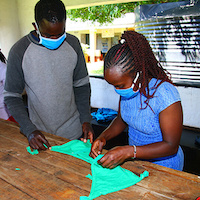The challenge of healthcare provision to remote communities
Today’s Harambee blog takes us — in the company of Claire Hallinan and Jane Stanley — on a trip that shows the challenge of providing adequate health care to remote communities — but also the real difference it can make to people’s lives.
On Saturday the 8th of November we set off from Londiani early in the morning, stopping at a nearby monastery and the local hospital for a brief tour. We then began a trek that took us through the stunning Rift Valley.
We were struck by the immense beauty of the area — the lush green hills and maize fields, the homesteads dotted in the distance and an abundance of colourful flowers and trees. We were enthusiastically greeted by local families and gorgeous smiling children, many of whom had never seen mzungus (white people) before.
The stark contrast between the natural beauty of Katung and the poverty that these families endure was not lost on us. Nor was the remoteness of where we were and the difficulty these people have in accessing healthcare. The roads to this area are barely more than rocky paths, which turn to mudslides with the first shower, which are torrential — as we soon found out. Seeing this remoteness first hand brought home to us the value and importance of the Wilderness First Aid (WFA) course and of access to healthcare facilities and antenatal care. A woman in labour or an injured person would have to be carried by blanket or donkey and cart for hours to reach a health care facility. It’s hard to imagine.
On Monday 10th of November another beautiful sunny day greeted us as we set off early with the local Public Health Officers to administer polio vaccines to children in the Chebowar and Lemotit districts. This involved walking from house to house and school to school, recording the numbers of children vaccinated and households visited. Our plans to visit each house individually to get a correct record of the children living there was soon abandoned as word spread of the mzungus giving out sweets! Masses of kids came from all directions and it became more of a social event with a lot of laughter — and a few tears from some of the younger children! Our visit to Lemotit primary school was one of the highlights; we couldn’t help but join in with the laughter of the hundred or so kids.
During Monday and Tuesday we could see the differences between communities with a current Community Health Unit and those with no unit. The homesteads in Chebowar where the unit has only just started training, had a few safe and clean pit latrines and hand washing facilities, as well as the smokeless stoves we had helped to install last week. We also met some new Community Health Workers (CHWs) who would be attending the next WFA course.
By contrast, the Lemotit community, where it is hoped a unit will be set up next year, had none of these facilities. We were distressed to see a number of small children and new-born babies who had their beds in the warm kitchens, which were full of smoke. Once again the urgent need for smokeless stoves and basic health education was apparent. It was encouraging therefore when a number of women from Lemotit told us that they were very much looking forward to taking part in the community unit and in receiving and passing on health education.

